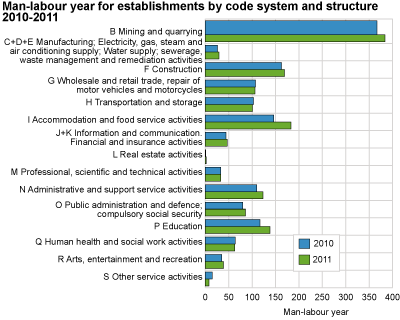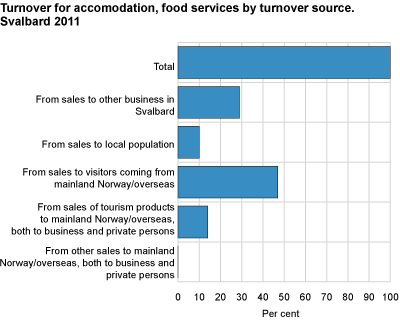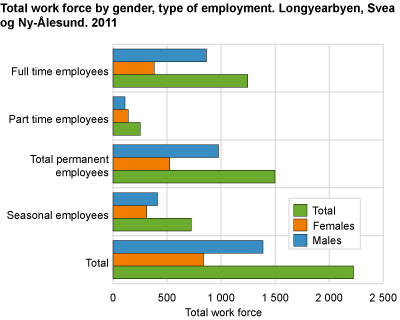Content
Published:
This is an archived release.
Further decrease in turnover in Svalbard
Turnover for local KAUs operating in Svalbard declined 2.9 per cent to NOK 3.5 billion from 2010 to 2011. Meanwhile, the number of FTEs rose 7 per cent to 1 511.
In 2011, many industries in Svalbard posted a decrease in turnover. In mining and quarrying, turnover
declined by NOK 75 million. The decrease reflected lower coal sales quantities from the Svea Nord core and from the Gruve 7 mine. According to the annual report for Store Norske Spitsbergen Kullkompani AS, coal sales from Svea totalled 1.60 million tonnes in 2011, compared with 1.65 million tonnes in 2010. Coal sales figures from the Gruve 7 mine were 69 200 tonnes, up from 65 200 tonnes in 2010.
The highest decrease in turnover was found in construction, from about NOK 485 million in 2010 to NOK 390 million in 2011, down by NOK 95 million. Mining and quarrying continued to be the largest industry, representing almost 41 per cent of the total turnover of all the industries in Svalbard in 2011. The corresponding share for the construction industry was 11 per cent. In transportation and storage, turnover rose 20 per cent to NOK 286 million. Turnover in information and communication, financial and insurance activities increased by over 10 per cent to almost NOK 259 million.
Increase in FTEs
The number of FTEs in 2010 reached 1 511 for the local KAUs operating in Svalbard in 2011; 100 FTEs more than in 2010. The largest increase came in accommodation and food service activities, up 25.4 per cent - or by 37 FTEs - compared with 2010. A similar increase in job creation was also observed in other industries. The total FTEs increased by virtually 21, or over 17 per cent in education.
Employment gains in all positions
The number of people working in Svalbard rose by 284 from 2010 to 2011. Employment gains in 2011 were spread across all types of positions. The largest employment gain was found among seasonal workers, with an increase of 213. The workforce varies because of seasonal fluctuations of tourism. Employment in full-time positions rose by over 2.3 per cent to 865 among men, while decreasing by 3.3 per cent to 382 among women. For regular part-time positions, employment rose by 64, with most of the increase among men.
Over NOK 400 million in public subsidies
Public subsidies to industries in Svalbard came to NOK 400.6 million in 2011; up NOK 14.4 million compared with 2010. Most of the public subsidies were received by Local KAUs operating within public administration, defence and compulsory social security and education, with an amount of NOK152 million, up by NOK 10 million compared with 2010.
Decrease in investments
Industries in Svalbard reported spending of nearly NOK 381 million on capital investments in 2011; a 29.5 per cent decrease compared with 2010. The largest decrease occurred in real estate activities, where investment declined 57.6 per cent to NOK 52 million, reflecting the completion of several house building projects. Within transportation and storage, investment decreased by NOK 49 million, to NOK 26.4 million. Mining and quarrying also recorded an important loss in investments in 2011, falling by NOK 32.7 million to over 132 NOK million.
Increased turnover for accommodation and food service activities
The turnover in accommodation and food service activities increased from NOK 207 million in 2010 to over NOK 218 million in 2011. The proportion of sales to other establishments in Svalbard accounted for 29 per cent of the total turnover from accommodation and food service activities in 2011. As regards sales of tourism products to tourists visiting Svalbard, this share was 47 per cent. Sales of tourism products to mainland Norway/abroad - both to firms and private persons- represented 14 per cent of the total turnover in accommodation and food service activities.
|
Business statistics for Svalbard include the Norwegian settlement in Longyearbyen, Svea and Ny-Ålesund. The Russian settlement is not included. |
|
The industries are classified according to the Standard Industrial Classification (SIC2007), which is based on the EU’s industrial standard NACE Rev. 2 and the UN’s industrial standard ISIC Rev.3. |
|
Public subsidies comprise allocations received from the government, the local government in Longyearbyen and other public bodies (e.g. Innovation Norway) for operations and investments. |
|
Statistics Norway is responsible for the data collection for industry statistics for Svalbard from the reference year 2008 onwards. The industry statistics serve as an instrument to monitor the development at Svalbard, both for the government and for the local population. In order to be able to compare the industry statistics for Svalbard with the structural business statistics for mainland Norway, the data collection in Svalbard has been carried out using the same principles as for the structural business statistics for mainland Norway. |
Tables:
Contact
-
Mikael Sandberg
E-mail: mikael.sandberg@ssb.no
tel.: (+47) 40 81 14 99



